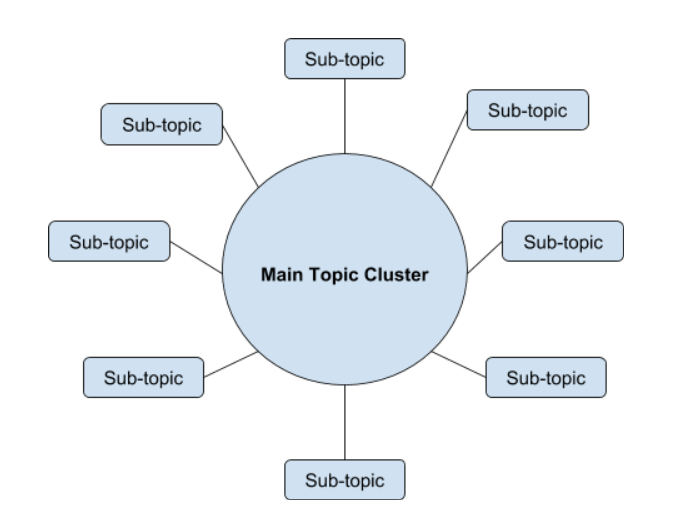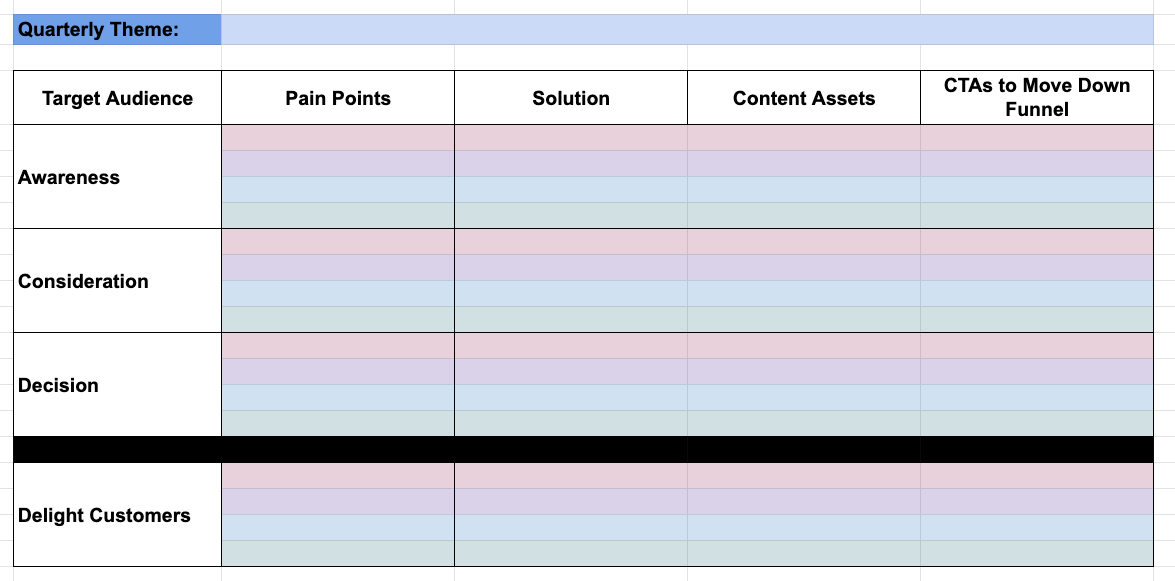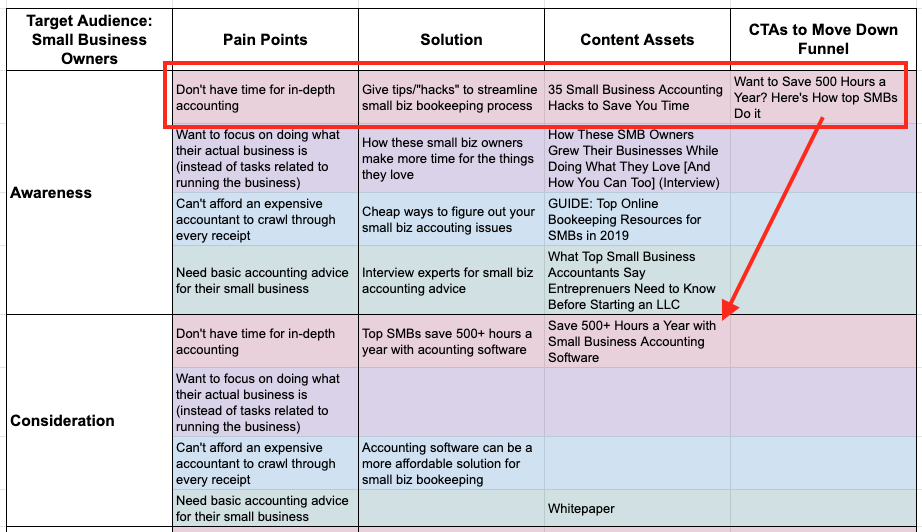Topic clusters are based on the idea that marketers create a single page to serve as the “hub” for a particular subject.
From there, all the sub-topic posts related to that subject hub are linked from that main topic page – almost like a wheel.

If you’ve been in marketing for at least a minute, chances are you’ve heard about topic clusters or hubs.
This model is great for SEO. It ensures that pages on our site are all internally linked, related to the overall brand identity, and structured well for users to find what they need.
But there’s something missing from this model: figuring out what the user actually needs.
Targeting the ‘Imaginary Audience’
In digital marketing, it’s easy to become detached from our target audience. We end up optimizing our sites for ourselves, our peers and who we think our target audiences are.
Senior Conversion Optimizer at Unbounce, Michael Aagaard calls this optimizing for an “imaginary target audience.”
We think our product or service is amazing. We know the ins and outs. We know how it could change our audience’s lives.
And we make the mistake of peddling the drill – when the buyer just wants a hole in the wall.
Creating a User-Focused Topic Matrix
To remedy this inward-looking content generation method, I propose a user-focused content matrix.
Bonus: Read to the end to get your copy of the content planning matrix.
Anyone can create it in a spreadsheet, and the idea is that you create pillars of content around your target audience.
The “hub page” can be focused around the main target-user or the target user’s pain points. The spokes are the content related to each.
You can create multiple matrices per quarter or whatever time period you use for each user type you’d like to address.
This method ensures that our content isn’t just a self-congratulatory pat on the back – but actually gives users what they’re looking for online and helps move them down our sales and marketing cycle funnel.

1. Set Themes Around Company Targets
The first step in the content matrix for topic clusters is to tie your quarterly (or whatever time period makes sense for your business) theme to your business goals.
For the example in this article, I chose to create a matrix for accounting software. One of their goals for this quarter is to increase subscriptions to their small business accounting suite.
By setting a quarterly theme that’s based on company objectives, you’re helping create measurable content.
With tools like Google Analytics, you can easily tell how many people are coming to each of these pieces of content, flowing to the next stage of the funnel, and converting from the CTAs on your Bottom of Funnel content pieces.

2. Choose a Target Audience
Each matrix should have its own specific target audience. The spreadsheet model means you can have multiple tabs for one quarter that plan out your content per target audience.
If your business type generally has a single target audience, think of ways to subdivide them into categories and get as granular as possible about their needs and pain points. The deeper the dive, the more tailored and useful your content will be.
This can also be a way to test out new target audiences or delve into smaller audiences that you want to grow.
By choosing to focus your content ideation around a specific audience (instead of all audiences at once), you can tailor your messaging, content flow, CTAs, and more.
3. Discover 4 Pain Points
What are pain points?
A pain point is an explicit or implicit issue or obstacle your target audience is experiencing. This part is truly key to the whole matrix’s effectiveness and measurability.
The key to the most compelling content is figuring out what users are searching when they don’t know your product or service will solve their problem (a.k.a., mind reading and magic).
WordStream names four different types of pain points that consumers face:
- Financial: Something isn’t as cost-effective as the user needs it to be.
- Productivity: Prospects are wasting time with unproductive and wasteful operations.
- Process: Their business procedures waste time or are ineffective.
- Support: Your customers need help in key stages of business change.

How do I figure out my customer pain points?
Talk to them
The easiest way to determine your customers’ pain points is to just talk to them.
Either find time to interview your existing customers in that target audience or ask to meet with some prospective customers in exchange for some type of compensation.
(Check “Don’t Make Me Think” by Steve Krug for a quick intro to user-testing and audience interviews when you don’t have a huge budget.)
At a prior job, the product marketing team interviewed tons of existing and potential customers in a certain group for a company project. I was amazed when we found out that all the problems we thought this group had were actually inconsequential to them. It changed the scope of the whole project.
Survey them
If you can’t find the time or money to talk one-on-one with your target audience, a survey would be the next best choice.
Make sure you phrase your questions in a way that doesn’t influence answers, and your research and examine their issues beforehand.
You can pay to distribute this survey to a targeted group or email list. Or you can just put it out there to everyone and take the good with the bad – sorting through potentially extraneous data. It’s better than no data.
Google them
As an introvert, this is my go-to strategy. But I put it last here because there is benefit in talking to actual people first.
The internet is full of articles, forum complaints, Twitter threads, and more related to your prospects’ pain points. You just have to do the digging to find them.
4. Address Pain Points Corresponding with Funnel Stage
Once you have your list of pain points for this specific cycle of content, plan out how you will address them at each stage of the funnel.
Too often, content creators write top of funnel content and make the mistake of trying to force people down the funnel too quickly.
“Trying to find out which running shoe is best for you? BUY THIS ONE NOW OR ELSE!”
We have to recognize that there’s a natural flow to the research and buying cycle, and it behooves us to cater to it instead of trying to circumvent it.
Here are my tips for approaching each stage of the funnel:
- Top of funnel – Awareness: The user is just figuring out that they might have an issue. Tell them why that’s a problem for them and that they should research solutions.
- Middle of funnel – Consideration: Now that they know they have an issue and should be looking for a solution, tell them how your genre or product or service is the step in the right direction.
- Bottom of funnel – Decision: Convince the user that your specific product or service is the one they need to resolve their pain points.
- Post-sale – Delight: Too many content strategies forget this one. Make sure to delight your existing users. Make it easy for them to refer more clients to you. Think about what this type of content looks like for your business.
In the matrix, you’ll put the funnel-focused solutions to the audience’s pain points in the corresponding Solution cell.
From that solution, you’ll create a content topic idea that corresponds to that funnel-stage solution:

5. Use Thoughtful CTAs to Move Users to the Next Stage
Once you have the pain points, solutions, and content assets mapped out for each stage of the funnel, it’ll be easy to see what calls to action you need to use to move your audience from one stage to the next for each specific issue.
Don’t try to skip from 0 to 100.
Each row color corresponds with the same row color in the next funnel stage. This means that if one pain point resonates with a reader, you can point them to the content in the next funnel stage for the same pain point.

6. But What about the Delight Rows in the Content Matrix Sheet?
Once your reader has converted into a customer, the Delight phase of content gives them tools to actually iron out those pain points with your solution.
And when they’re so pleased with how you’ve made their lives and work easier, you can ask for reviews or referrals as the CTA.

7. Now Get to the ABCs (Always Be Converting)
Ready to get started?
Here’s the content matrix template.
Now that you’ve spent all this time mapping your content matrix, don’t just plow through the actual content creation like it’s already done for you.
- Be thoughtful and thorough.
- Create links to your existing content.
- Reference data and outside sources.
- Be mindful of the funnel stage so you’re not trying to cram people down when they’re not ready to buy.
- Write the content that actually serves your users’ needs – not your idea of their needs.
- Be selfless in the giving away of ideas.
And reap the conversions!
More Resources:
- How to Create an Audience-Focused Content Strategy That Drives Conversions
- Using 6 Principles of Persuasion to Increase Conversions
- Content Marketing KPIs: Your Guide to Picking the Right KPIs for Content
Image Credits
All screenshots taken by author, March 2019


